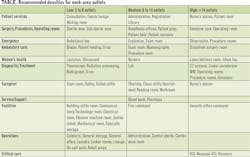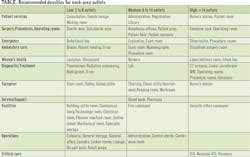TIA's TR-42 Committee bustling with activity
By Patrick McLaughlin
The Telecommunications Industry Association’s (TIA) TR-42 Telecommunications Cabling Systems Committee meets three times per year, developing and revising standard documents for telecommunications cabling systems that are used predominantly in North America. The group’s subcommittees, within which much of the standards-development legwork takes place, meet more frequently. TR-42 met the week of June 12-16, and is scheduled to meet again the week of September 18, then again the week of January 29, 2018. TR-42 develops standards in accordance with the processes and procedures established by ANSI - the American National Standards Institute. As such, TIA standards include “ANSI” in their titles, e.g. ANSI/TIA-568.2-D.
This article reports on activities that took place within TR-42 and some of its subcommittees during the June meeting. We will continue to follow this committee’s activities and report them to you regularly.
942-B data center standard approved
TR-42 approved the ANSI/TIA-942-B Telecommunications Infrastructure Standard for Data Centers. During the June meeting, the TR-42.1 subcommittee, which is responsible for the 942 standard series, resolved all default-ballot comments and approved the 942-B standard to publish.
As the TIA explained when it began the “B” revision process on ANSI/TIA-942 in 2015, the standard “specifies the minimum requirements for telecommunications infrastructures of data centers and computer rooms, including single-tenant enterprise data centers and multi-tenant internet hosting data centers. The topology specified in standards is intended to be scalable to any size data center.” The TIA added that the standard “serves as a critical tool to evaluate existing data centers and communicate design requirements for new data centers. These include cabling, facility and network design elements.”
The completed ANSI/TIA-942-B standard includes the following, among many other, changes from the “A” revision.
- It incorporates Addendum 1 to the 942-A standard, which addresses data center fabrics, as an Annex.
- It adds 16- and 32-fiber MPO-style array connectors as an additional connector type for termination of more than two fibers. The 16- and 32-fiber connectors were standardized when ANSI/TIA-604-18 was published in 2016.
- It adds Category 8 as an allowed type of balanced twisted-pair cable, and changes the recommendation for Category 6A balanced twisted-pair cable to Category 6A or higher.
- It adds Om5 as an allowed fiber type. The TIA-492-AAAE standard specifies Om5 fiber, which is designed to support short-wavelength division multiplexing.
Cabling for healthcare facilities standard approved
TR-42 also approved for publication the ANSI/TIA-1179-A Healthcare Facility Telecommunications Infrastructure Standard. The “A” in the standard’s title indicates it is the first revision of the original 1179 standard, which was published in 2010.
A key element of the 1179-A standard, which was retained from the original document, is a table of recommended work-area outlet densities for different areas in a healthcare facility.
While the 1179-A standard was in progress, Legrand North America’s director of eLearning and standards Cindy Montstream provided an update of its development. Montstream listed the following significant changes from the original 1179 standard document.
- Balanced twisted-pair backbone cabling is Category 6A minimum
- Balanced twisted-pair horizontal cabling is Category 6A minimum
- Om4 is the recommended minimum for multimode optical-fiber cabling
- A minimum of two fibers are required for optical-fiber backbone cabling
- Array connectors are permitted for optical-fiber cabling in the work area
- MUTOAs (multi-user telecommunications outlet assemblies) and consolidation points may be used as additional network elements
- Requirements were added for: telecommunications pathways and spaces (additional requirements to those in ANSI/TIA-569-D); bonding and grounding; firestopping; broadband coaxial cabling; multi-tenant building spaces
- Recommendations were added for cabling for wireless access points and distributed antenna systems
Multiple projects for single-twisted-pair cabling
In June TR-42 initiated four standards projects related to single-twisted-pair cabling systems.
One of those projects is the effort that ultimately will result in the publication of ANSI/TIA-568.5, specifying single-twisted-pair cabling and components. The standard will provide specifications for cables, connectors, cords, links, and channels using one-pair connectivity in non-industrial networks, according to a working statement of the standard’s scope. The standard will be geared toward what are called “MICE1” environments. MICE is an acronym for mechanical, ingress, climatic, and electromagnetic. The TIA-1005 standard series includes MICE tables, which numerically characterize the network environment’s severity for each of the four conditions. The higher the number, the more severe the environment. In practical application, a MICE1 environment is a commercial office space.
Another effort that TR-42 initiated in June is an addendum (Addendum 2) to the ANSI/TIA-568.0-D standard. The addendum will add single balanced twisted-pair use cases, topology, and architecture to the standard. “The standard will include installation requirements and additional guidelines for transitioning from 4-pair to 1-pair cabling,” says an early-stage scope of the standard.
Also on TR-42’s docket, Addendum 2 to the ANSI/TIA-862-B Structured Cabling Infrastructure Standard for Intelligent Building Systems. Like the addendum to the 568.0-D spec, this one will add use cases, topology, and architecture for single-pair cabling.
Additionally, this document will provide single-twisted-pair cabling guidelines for emerging Internet of Things and machine-to-machine (m2M) applications that will require higher density, reduced size, and greater flexibility than can be provided by existing technology.
Finally, Addendum 4 to the ANSI/TIA-1005-A Telecommunications Infrastructure Standard for Industrial premises will specify cables, connectors, cords, links and channels using one-pair connectivity in MICE2 and MICE3 environments.
Subcommittee consolidation
Three subcommittees within TR-42 will consolidate into other subcommittees. At its closing plenary meeting on June 16, TR-42 agreed to consolidate TR-42.6 and TR-42.16 into TR-42.3, and to consolidate TR-42.10 into TR-42.1.
The TR-42.3 Commercial Building Telecommunications Pathways and Spaces subcommittee is responsible for the TIA-569 series of standards covering pathways and spaces. It now also will incorporate the work of the former TR-42.6 Telecommunications Infrastructure and Equipment Administration subcommittee, which is responsible for the TIA-606 series of administration standards and the TIA-5048 automated infrastructure management standard. TR-42.3 also now will incorporate the work of the former TR-42.16 Premises Telecommunications Grounding and Bonding subcommittee, which is responsible for the 607 series of earthing/grounding and bonding standards.
The TR-42.1 Commercial Building Telecommunications Cabling subcommittee is responsible for a number of standards, including 568, 942 (data center), 570 (residential), 862 (intelligent buildings), 1179 (healthcare), 4996 (education), and others. The subcommittee now also will incorporate the work of the former TR-42.10 Sustainable Information Communications Technology subcommittee.
At its June meeting, TR-42.10 approved for publication telecommunications systems bulletin TSB-5046 Process for Sustainable Information Communications Technology Manufacturers.
When TR-42 meets this month, TR-42.1 and TR-42.3 each will review the creation of a new name and scope for the group.
Patrick McLaughlin is our chief editor.

